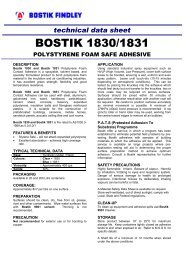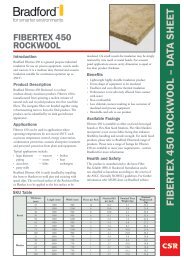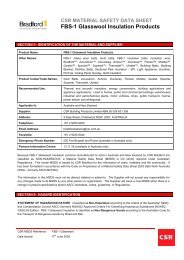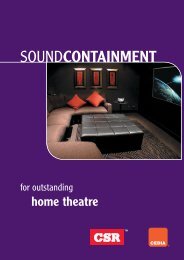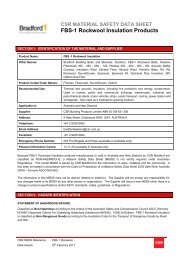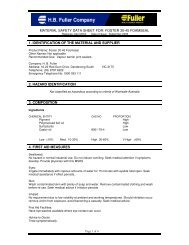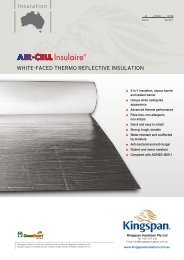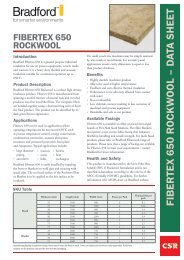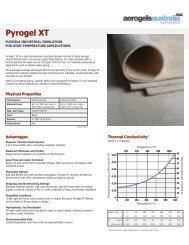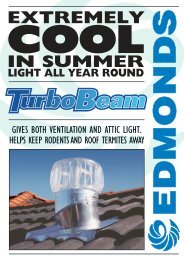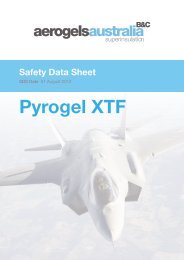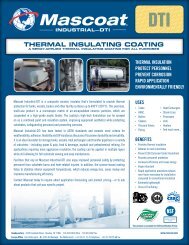Cryogel Z MSDS 2012 - Insulation Industries
Cryogel Z MSDS 2012 - Insulation Industries
Cryogel Z MSDS 2012 - Insulation Industries
Create successful ePaper yourself
Turn your PDF publications into a flip-book with our unique Google optimized e-Paper software.
superinsulation<br />
Safety Data Sheet<br />
SDS Date 01 August <strong>2012</strong><br />
<strong>Cryogel</strong> Z
Product Name<br />
CRYOGEL Z<br />
1. IDENTIFICATION OF THE MATERIAL AND SUPPLIER<br />
Supplier Name<br />
AEROGELS AUSTRALIA PTY. LTD.<br />
Address 174 Fullarton Road, Dulwich, SA, AUSTRALIA, 5065<br />
Telephone +61 (0) 8 8363 7563<br />
Emergency +61 (0) 8 8363 7563<br />
Email<br />
OHS@aerogel.com.au<br />
Synonym(s)<br />
SILICA AEROGEL MATERIAL<br />
Use(s)<br />
INSULATING COMPOUND<br />
SDS Date 01 August <strong>2012</strong><br />
2. HAZARDS IDENTIFICATION<br />
NOT CLASSIFIED AS HAZARDOUS ACCORDING TO SAFE WORK AUSTRALIA CRITERIA<br />
RISK PHRASES<br />
None allocated<br />
SAFETY PHRASES<br />
None allocated<br />
NOT CLASSIFIED AS A DANGEROUS GOOD BY THE CRITERIA OF THE ADG CODE<br />
UN Number<br />
Packing Group<br />
Hazchem Code<br />
None Allocated<br />
None Allocated<br />
None Allocated<br />
DG Class<br />
Subsidiary Risk(s)<br />
None Allocated<br />
None Allocated<br />
3. COMPOSITION/ INFORMATION ON INGREDIENTS<br />
Ingredient Identification Classification Content<br />
ALUMINIUM CAS: 7429-90-5 F+;R15 F;R17<br />
Product Name<br />
CRYOGEL Z<br />
Advice to Doctor<br />
Due to product form and application, ingestion is considered unlikely.<br />
Treat symptomatically.<br />
5. FIRE FIGHTING MEASURES<br />
Flammability<br />
Fire and Explosion<br />
Extinguishing<br />
Hazchem Code<br />
Non flammable. May evolve toxic gases (carbon oxides) when heated to decomposition.<br />
No fire or explosion hazard exists.<br />
Prevent contamination of drains or waterways.<br />
None Allocated<br />
6. ACCIDENTAL RELEASE MEASURES<br />
Spillage<br />
If spilt/ packages damaged, collect for later disposal or reuse. For large spills, use personal<br />
protective equipment. Contain spillage, then cover / absorb spill with non-combustible absorbent<br />
material (vermiculite, sand, or similar), collect and place in suitable containers for disposal. Avoid<br />
generating dust.<br />
7. STORAGE AND HANDLING<br />
Storage<br />
Handling<br />
Store in a cool, dry, well ventilated area, removed from acids and foodstuffs. Ensure containers are<br />
adequately labelled, protected from physical damage and sealed when not in use.<br />
Before use carefully read the product label. Use of safe work practices are recommended to avoid<br />
eye or skin contact and inhalation. Observe good personal hygiene, including washing hands before<br />
eating. Prohibit eating, drinking and smoking in contaminated areas.<br />
8. EXPOSURE CONTROLS / PERSONAL PROTECTION<br />
Exposure Standards<br />
Ingredient<br />
Reference<br />
TWA<br />
STEL<br />
ppm mg/m³ ppm mg/m³<br />
Aluminium (metal dust) SWA (AUS) -- 10 -- --<br />
Aluminium (welding fumes) (as Al) SWA (AUS) -- 5 -- --<br />
Aluminium, alkyls (NOC+) (as Al) SWA (AUS) -- 2 -- --<br />
Aluminium, pyro powders (as Al) SWA (AUS) -- 5 -- --<br />
Aluminium, soluble salts (as Al) SWA (AUS) -- 2 -- --<br />
Non-respirable fibres, inspirable dust SWA (AUS) -- 2 -- --<br />
Synthetic mineral fibres (SMF) SWA (AUS) -- 0.5 f/ml -- --<br />
Biological Limits<br />
Engineering Controls<br />
No biological limit allocated.<br />
Avoid inhalation. Use in well ventilated areas. Where an inhalation risk exists, mechanical extraction<br />
ventilation is recommended. Maintain dust levels below the recommended exposure standard.<br />
PPE<br />
Eye / Face<br />
Hands<br />
Body<br />
Respiratory<br />
Wear dust-proof goggles.<br />
Wear latex or nitrile gloves.<br />
Wear coveralls.<br />
Where an inhalation risk exists, wear a Class P1 (Particulate) respirator.<br />
Page 2 of 5<br />
SDS Date: 01 Aug <strong>2012</strong>
Product Name<br />
CRYOGEL Z<br />
9. PHYSICAL AND CHEMICAL PROPERTIES<br />
Appearance<br />
WHITE FABRIC BLANKET WITH FOIL LAMINATE<br />
Odour<br />
ODOURLESS<br />
Flammability<br />
NON FLAMMABLE<br />
Flash point<br />
NOT APPLICABLE<br />
Boiling point<br />
NOT APPLICABLE<br />
Melting point<br />
NOT APPLICABLE<br />
Evaporation rate<br />
NOT APPLICABLE<br />
pH<br />
NOT APPLICABLE<br />
Vapour density<br />
NOT APPLICABLE<br />
Specific gravity<br />
NOT APPLICABLE<br />
Solubility (water)<br />
INSOLUBLE<br />
Vapour pressure<br />
NOT APPLICABLE<br />
Upper explosion limit NOT APPLICABLE<br />
Lower explosion limit NOT APPLICABLE<br />
Autoignition temperature NOT APPLICABLE<br />
Decomposition temperature NOT APPLICABLE<br />
Viscosity<br />
NOT APPLICABLE<br />
Partition coefficient<br />
NOT APPLICABLE<br />
10. STABILITY AND REACTIVITY<br />
Chemical Stability<br />
Conditions to Avoid<br />
Material to Avoid<br />
Hazardous Decomposition<br />
Products<br />
Hazardous Reactions<br />
Stable under recommended conditions of storage.<br />
Avoid heat, sparks, open flames and other ignition sources.<br />
Incompatible with hydrofluoric acid (may evolve toxic silicon tetrafluoride gas).<br />
May evolve toxic gases (carbon oxides) when heated to decomposition.<br />
Polymerization will not occur.<br />
11. TOXICOLOGICAL INFORMATION<br />
Health Hazard<br />
Summary<br />
Eye<br />
Inhalation<br />
Skin<br />
Ingestion<br />
Low toxicity - low irritant. Use safe work practices to avoid eye or skin contact and inhalation. Chronic<br />
exposure to amorphous silica is not anticipated to result in lung disease, however those individuals<br />
with impaired function respiratory or disease are advised to avoid exposure.<br />
Low to moderate irritant. Contact may result in irritation, lacrimation, pain and redness.<br />
Low irritant. Over exposure may result in irritation of the nose and throat, with coughing.<br />
Low irritant. Prolonged or repeated contact may result in mechanical irritation.<br />
Low toxicity. Ingestion may result in gastrointestinal irritation, nausea and vomiting.<br />
Toxicity Data MAGNESIUM HYDROXIDE (1309-42-8)<br />
LD50 (ingestion)<br />
8500 mg/kg (rat, mouse)<br />
LD50 (intraperitoneal) 815 mg/kg (mouse)<br />
TDLo (ingestion)<br />
2747 mg/kg (infant)<br />
12. ECOLOGICAL INFORMATION<br />
Environment<br />
Persistence/Degradability<br />
Mobility<br />
The main component/s of this product are not anticipated to cause any adverse effects to plants or<br />
animals.<br />
Not applicable for inorganic material.<br />
None expected due to insoluble nature of product<br />
13. DISPOSAL CONSIDERATIONS<br />
Waste Disposal<br />
Legislation<br />
Reuse where possible. No special precautions are required for this product.<br />
Dispose of in accordance with relevant local legislation.<br />
Page 3 of 5<br />
SDS Date: 01 Aug <strong>2012</strong>
Product Name<br />
CRYOGEL Z<br />
14. TRANSPORT INFORMATION<br />
NOT CLASSIFIED AS A DANGEROUS GOOD BY THE CRITERIA OF THE ADG CODE<br />
LAND TRANSPORT<br />
(ADG)<br />
SEA TRANSPORT<br />
(IMDG / IMO)<br />
AIR TRANSPORT<br />
(IATA / ICAO)<br />
UN Number<br />
Proper Shipping Name<br />
None Allocated<br />
None Allocated<br />
None Allocated<br />
None Allocated<br />
None Allocated<br />
None Allocated<br />
DG Class/ Division<br />
Subsidiary Risk(s)<br />
Packing Group<br />
Hazchem Code<br />
None Allocated<br />
None Allocated<br />
None Allocated<br />
None Allocated<br />
None Allocated<br />
None Allocated<br />
None Allocated<br />
None Allocated<br />
None Allocated<br />
None Allocated<br />
15. REGULATORY INFORMATION<br />
Poison Schedule<br />
Inventory Listing(s)<br />
A poison schedule number has not been allocated to this product using the criteria in the Standard<br />
for the Uniform Scheduling of Medicines and Poisons (SUSMP)<br />
AUSTRALIA: AICS (Australian Inventory of Chemical Substances)<br />
All components are listed on AICS, or are exempt.<br />
UNITED STATES: TSCA (US Toxic Substances Control Act)<br />
All components are listed on the TSCA inventory, or are exempt.<br />
16. OTHER INFORMATION<br />
Additional Information<br />
Under certain conditions, the product may have a faint ammonia like odour.<br />
RESPIRATORS: In general the use of respirators should be limited and engineering controls<br />
employed to avoid exposure. If respiratory equipment must be worn ensure correct respirator<br />
selection and training is undertaken. Remember that some respirators may be extremely<br />
uncomfortable when used for long periods. The use of air powered or air supplied respirators should<br />
be considered where prolonged or repeated use is necessary.<br />
PERSONAL PROTECTIVE EQUIPMENT GUIDELINES:<br />
The recommendation for protective equipment contained within this ChemAlert report is provided as<br />
a guide only. Factors such as method of application, working environment, quantity used, product<br />
concentration and the availability of engineering controls should be considered before final selection<br />
of personal protective equipment is made.<br />
HEALTH EFFECTS FROM EXPOSURE:<br />
It should be noted that the effects from exposure to this product will depend on several factors<br />
including: frequency and duration of use; quantity used; effectiveness of control measures; protective<br />
equipment used and method of application. Given that it is impractical to prepare a ChemAlert report<br />
which would encompass all possible scenarios, it is anticipated that users will assess the risks and<br />
apply control methods where appropriate.<br />
Page 4 of 5<br />
SDS Date: 01 Aug <strong>2012</strong>
Product Name<br />
CRYOGEL Z<br />
Abbreviations<br />
ACGIH<br />
CAS #<br />
CNS<br />
EC No.<br />
GHS<br />
IARC<br />
LD50<br />
mg/m³<br />
PEL<br />
pH<br />
ppm<br />
REACH<br />
STOT-RE<br />
STOT-SE<br />
SUSMP<br />
TLV<br />
TWA/OEL<br />
American Conference of Governmental Industrial Hygienists<br />
Chemical Abstract Service number - used to uniquely identify chemical compounds<br />
Central Nervous System<br />
EC No - European Community Number<br />
Globally Harmonized System<br />
International Agency for Research on Cancer<br />
Lethal Dose, 50% / Median Lethal Dose<br />
Milligrams per Cubic Metre<br />
Permissible Exposure Limit<br />
relates to hydrogen ion concentration using a scale of 0 (high acidic) to 14 (highly<br />
alkaline).<br />
Parts Per Million<br />
Regulation on Registration, Evaluation, Authorisation and Restriction of Chemicals<br />
Specific target organ toxicity (repeated exposure)<br />
Specific target organ toxicity (single exposure)<br />
Standard for the Uniform Scheduling of Medicines and Poisons<br />
Threshold Limit Value<br />
Time Weighted Average or Occupational Exposure Limit<br />
Revision History<br />
Revision<br />
1.0<br />
Description<br />
Initial SDS Creation<br />
Report Status<br />
This document has been compiled by RMT on behalf of the manufacturer of the product and<br />
serves as the manufacturer's Safety Data Sheet ('SDS').<br />
It is based on information concerning the product which has been provided to RMT by the<br />
manufacturer or obtained from third party sources and is believed to represent the current state of<br />
knowledge as to the appropriate safety and handling precautions for the product at the time of<br />
issue. Further clarification regarding any aspect of the product should be obtained directly from<br />
the manufacturer.<br />
While RMT has taken all due care to include accurate and up-to-date information in this SDS, it<br />
does not provide any warranty as to accuracy or completeness. As far as lawfully possible, RMT<br />
accepts no liability for any loss, injury or damage (including consequential loss) which may be<br />
suffered or incurred by any person as a consequence of their reliance on the information<br />
contained in this SDS.<br />
Prepared By<br />
Risk Management Technologies<br />
5 Ventnor Ave, West Perth<br />
Western Australia 6005<br />
Phone: +61 8 9322 1711<br />
Fax: +61 8 9322 1794<br />
Email: info@rmt.com.au<br />
Web: www.rmt.com.au<br />
Revision:<br />
SDS Date:<br />
1<br />
01 August <strong>2012</strong><br />
End of SDS<br />
Page 5 of 5<br />
SDS Date: 01 Aug <strong>2012</strong>



